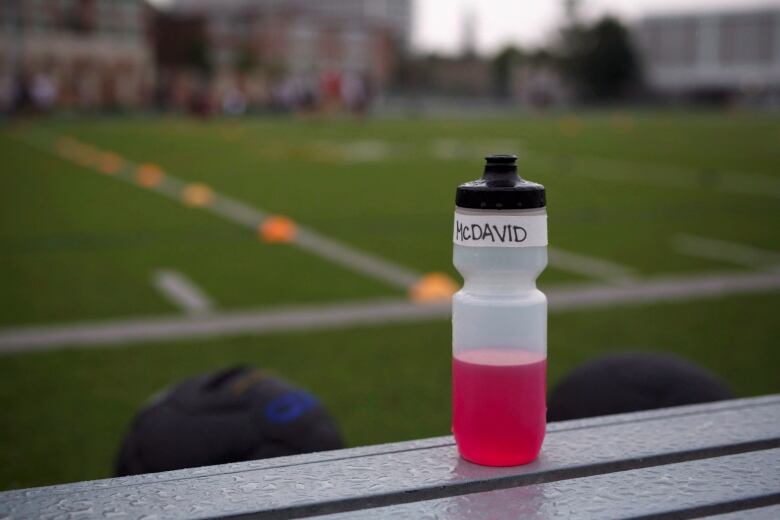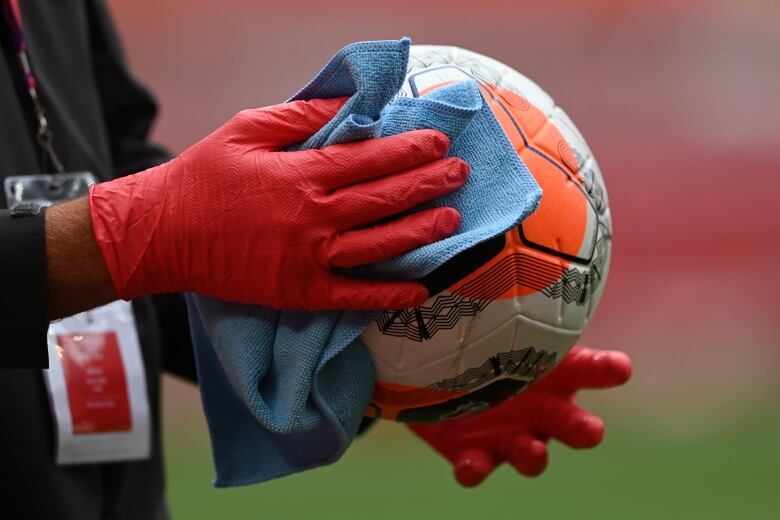Even the water bottles are 2 metres apart: Has COVID-19 changed team sports forever?
Hockey, soccer organizers say new measures will keep virus at bay, but at least one expert's not so sure

As recreational sports gradually resume across Ontario,organizers say they're taking the necessary steps to keep players safe. But do the strict new measures go far enough?
Brockville Braves coach Gene Falsetto, whose players are 15 to 20, saidCOVID-19 has fundamentally changed the way he runs the organization.Falsetto had to write to Hockey Canada and Hockey Eastern Ontario to outline the steps he would take to try to prevent the spread of COVID-19, in dressing rooms and on the ice, before his team could meet up last week.
He said both the players and their parents, who aren't yet allowed intothe arena,are more than happy to comply with the new rules if it means getting back to the game they love.
"They want to see things succeed," he said. "They're ecstatic, and so am I."
Among the many new rules:only nine players are allowed on the ice at a time during two60-minute practices each week;the focus is on skill development, and no contact between players is allowed; and water bottles must be placed two metres apart.

"I think being able to have a smaller group and being able to control that smaller group is much easier for coaches, for players, and I think it helps the parents ease their minds as well," Falsetto said.
Dressing rooms are for putting on helmets, gloves and skatesonly. That means players must arrive at the rink mostly dressed, like when they were little. Even then, Falsetto tries to keep the number of players in the room at any one time to four or five.
Soccer also making a comeback
Many of the new rules being adopted byrecreational soccer clubs mirror those in hockey.
"There is a consumer confidence right now that's very low,hence why it's very important that you have safety and protocols demonstrated in a graduated way," said Johnny Misley, CEO of Ontario Soccer, which has set out a three-phase plan to return to competitive playin the province.
Currently, all Ottawa clubs are still in Phase 1 of the plan, and have been since June 12. Players practise in groups of about four that have been told to stick together. For now, they stay two metres apart, even in their groups.
"It's good for the community, it's good for society and it's a nice way to ease back into normalcy," Misley said. "We're contributing to good mental health, and that's a huge concern right now."
Like hockey, it's unclear yet when games will resume. Misley said the rules will progress in lockstep with the province.
Weigh the risks, expert advises
While players may be champing at the bit to get back to regular competition, Dr. Gerald Evans, medical director of infection prevention and control at Kingston Heath Sciences Centre, says they and their parents should weigh the benefits against the potential costs.
In recent months, professionalbaseball and hockey players, along with golfersand other athletes, have tested positive for COVID-19, and Evans said that shows there may be something about group exercise that allows the respiratory illnessto spread. When that transmission is occurring is harder to nail down, however.

"The part that's hard to sort out is what part of it is the actual sport and what part of it is the social activities that occur around sports. That's a bit of an unknown," he said.
"We know that congregating in change rooms, from lessons in health care, is a particularly vulnerable time when transmission can occur."
Athletes produce more respiratory droplets when they're exerting themselves, and it's difficult to engage in aerobic activity while wearing a face mask, Evans pointed out.
"You've got to balance it. At the moment, as we're trying to get on top of this disease, is it worth the risk?" he asked. "There's nothing wrong with having a summer off where all you do is go swimming and hanging out in your backyard and not do anything else."













_(720p).jpg)


 OFFICIAL HD MUSIC VIDEO.jpg)
.jpg)



























































































